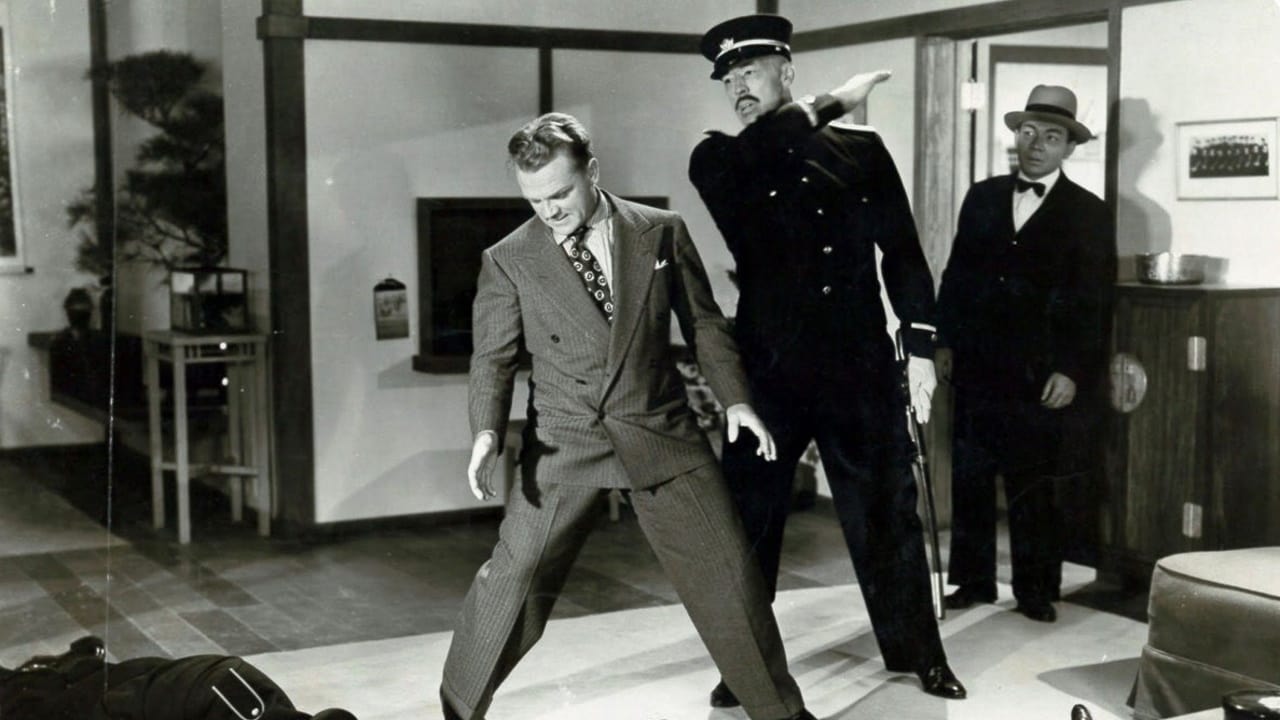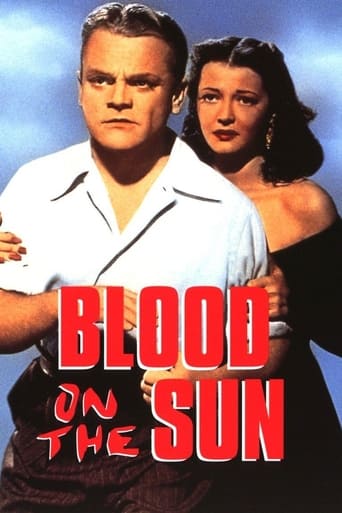

A different way of telling a story
... View MoreLet me be very fair here, this is not the best movie in my opinion. But, this movie is fun, it has purpose and is very enjoyable to watch.
... View MoreThis is a coming of age storyline that you've seen in one form or another for decades. It takes a truly unique voice to make yet another one worth watching.
... View MoreA film of deceptively outspoken contemporary relevance, this is cinema at its most alert, alarming and alive.
... View MoreBlood on the Sun (1945) I like James Cagney. I like him a lot. From The Public Enemy (1931) with Jean Harlow and a grapefruit, and Smart Money (1931) with Edward G. Robinson, through Ceiling Zero (1936) with Pat O'Brien. In Each Dawn I Die (1939), and as a surprisingly talented song-and-dance-man in Yankee Doodle Dandy (1942), through Ragtime (1981), the man demonstrated time and again that he was a high-energy, extremely likable actor with a somewhat varied range. He was even willing to play not particularly likable characters -- his supporting role as Captain Morton in Mister Roberts (1955) is an excellent example, and one of the few really good qualities in an otherwise mediocre film.But he was not particularly subtle or thoughtful or philosophical and his two-fisted, rock-'em, sock-'em approach to dicey international politics in Blood on the Sun (1945) turns what might have been a tale of intrigue about Japanese military ambitions well before Pearl Harbor into ridiculous farce. Indeed, after four solid years of war, and the expectation of as much as two or three years to go, it very probably appeared so to some US audiences in 1945. (While it seemed apparent in early 1945 that the war in Europe would likely be over in months, (and it was), if an invasion of the Japanese home islands proved to be necessary, it was expected -- based on previous experience in the Pacific campaign -- to be a protracted, very difficult fight.) Although it is never precisely explained, the apparent premise of the film is absurd. It seems to be that obtaining and publicizing a "secret" document outlining Japanese war plans in the mid-1930s or so, will somehow make a big difference in US posture and the progress of WWII after the latter conflict begins four-to-six years later.Observing the friction between the US and Japan over Pacific trade routes in the 1920s, George S. Patton, (long before he reached the rank of army general), commented that in all likelihood the US and the Japan would probably end up having to settle their issues with war. Being a professional warrior, Patton naturally framed the matter in such terms, but it shows that serious problems were apparent a decade and a half before the war began, and about a decade before the time when this movie supposedly takes place. The notion that the contents of a piece of paper would have made some kind of essential difference must have seemed silly, at best, and patronizing, at worst, not only to the men and women doing the fighting, but also to the men and women whose sons and daughters were being churned up in it.I don't object to period propaganda, but the scenes where Cagney bellows at the Japanese authorities demanding the civil rights he is "entitled" to as an American (regardless of the fact that he is an unwelcome guest in Imperial Japan) are flat out stupid, making his character appear to be a junior-grade moron and not a fearless newspaper editor taking risks to broadcast the truth. He's not even politically street-smart. What played well when Cagney was costumed in an inmate's prison garb and he was defiantly facing down the abusive warden of Leavenworth, say, comes across as ludicrous here. I sympathized with the Bad Guys: it was like they had a loud-mouthed, idiot child on their hands but refrained from putting him out of their misery merely through politeness.The Rape of Nanking. The Bataan Death March. But the movie expects us -- and US audiences in 1945 -- to believe that the Japanese high command would cower -- in their own country, no less -- before a newspaper editor who yowls about being held without due process of *US* law! Is the US supposed to declare war on Japan because Cagney is kept in jail before they kick him out of the country? (Which highlights another nonsensical plot device: Japan wants Cagney out and fast, so they give him TEN DAYS to mess around before he has to leave!)This ridiculous approach is maintained in just about every engagement, culminating in Cagney toppling an opponent about twice his size with his bare hands, eluding multiple enemy agents, getting slightly (but heroically) wounded, and surviving to be enfolded in the embrace of the light shining from the front windows of the US embassy which, along with the formidable presence of embassy official Hugh Beaumont, is more than enough to keep a few dozen vicious, sneaky evildoers at bay.As silly as the notion that without British assistance the Japanese didn't know how to build a bridge, but unlike David Lean's The Bridge on the River Kwai (1957), it is not a good movie in pretty much any respect.Produced by James' brother William, if you look at it right, I suppose this well-intentioned family project might contain a laugh or two but really is -- and always was -- just unworthy of both Cagney and its subject.XYZ
... View MoreBlood on the Sun intrigued me for a couple reasons. It was made in Hollywood about Japan, and it was released in 1945, and it marks a return to film after a 4 year hiatus for Sylvia Sidney.I would open by calling this movie moderately racist. I think anyone who has seen the film should find that agreeable. There's quite a lot of stereotypes as well as American actors dressing up as Japanese. That being said, I went in expecting that based on the time period when it was made.The movie contains one of the best action sequences of its time period, as well as one of the worst. The bad one comes near the beginning. In that scene Cagney takes on several Japanese military soldiers by himself but is ultimately knocked out cold by a very fake looking karate chop to the back of his neck. The good action sequence however comes at the very end of the movie. Cagney does his own stunts for this entire movie, so I give him a lot of credit for the strength of that scene. It uses long takes rather than short cuts, making it look more like real life and less like a movie.The big issue with the movie is that in the entire 98 minutes there was only one good scene. The beginning is slow until the early fight scene I already described. The extreme weakness of that scene leaves the movie looking cheap and campy. I mentally checked out of the movie at that point. By the time Sylvia Sidney arrived there wasn't a movie left to save.
... View MoreJames Cagney always has been one of my all time favorite actors, this was one of his first independent movies out of a big studio. This time James Cagney is an American journalist who lives in Tokio and must face to the fascism and stop the Japanese government plans..This film is also pioneer for be the first north American movie in have a martial arts fight in it and I dare to say that also one of the best..Cagney was a judo black belt and he was an amateur boxer, so his fight skills looks pretty good in front of the camera..in my opinion blood on the sun is an underrated film, very enjoyable, with great performances in which the star James Cagney shines in a special light
... View MoreBetter known for his portrayal of American Gangsters (Roaring Twenties, Kiss Tomorrow Goodbye), Cagney gives a decent performance in this film and at times brings elements of his gangster charm to the character he plays. The film therefore is entertaining for that purpose because it is that element of his style that makes James Cagney so watchable and what made him a legend. The story is not bad, interesting to get into but it is Cagney that makes it all worth watching. Also, the music in this film is really good. It sounds authentic Japanese, with the main theme accompanying most melodramatic scenes, transposed into one key or another. The fight scenes are good for the time bearing in mind the cast. Cagney actually performs a couple of Judo throws in some of them, although during some of the rougher stuff at the end there does appear to be a stunt double in place. Not too many classic quips to remember in this film apart from the very last line in the movie...I give this a 7/10
... View More